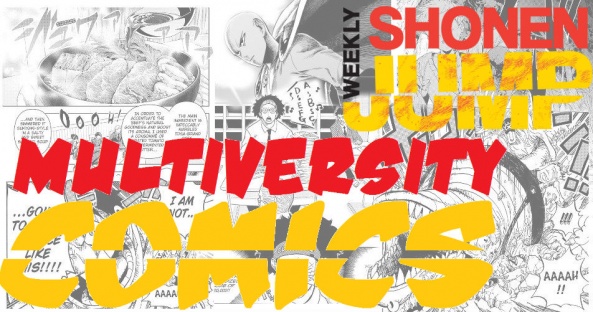
Welcome to This Week in Shonen Jump, our weekly check in on Viz’s various Shonen Jump series. Viz has recently changed their release format, but our format will mostly remain the same. We will still review the newest chapters of one title a week, now with even more options at our disposal. The big change for our readers is that, even without a Shonen Jump subscription, you can read these most recent chapters for free at Viz.com or using their app.
This week, Rowan checks in with “Akane-banashi.” If you have thoughts on this or any other current Shonen Jump titles, please let us know in the comments!

Akane-banashi Chapter 71
Written by Yuki Suenaga and illustrated by Takamasa Moue
Reviewed by Rowan Grover
I recently caught up on “Akane-banashi”, the manga on the lips of countless influential creators in the manga medium. Few works have constantly surprised me like this one. Every time I see Akane perform a new rakugo piece in a new framework, the question is always unconsciously posed: what more can I learn about rakugo that I haven’t already? How different can this be from the last one? And every time, I am blown away by the creativity and craft on display with Suenaga and Moue’s work.
In this chapter, we see the bulk of Akane performing the final piece that her father made infamous, “Changing Time”. Suenaga doesn’t actually dedicate a lot of this chapter to depicting the performance, cleverly we see how it is interpreted through several different perspectives. Starting with the art critic is wise at this point in the story. As readers seventy chapters deep into this narrative, we share a similar outsider understanding to the critic: while we don’t perform it, we are familiar enough with many of the mechanics that make it tick. We sit alongside watching as Akane manages to thrust the audience (both the manga readers and actual audience characters) deep within her process, and having the critic express wonder at her craft feels exciting.
Moving throughout the chapter, other perspectives begin to shed more light on what makes Akane’s performance so intricate and considered. This is often how things play out in “Akane-banashi” and having a large cast of varied characters that can interact with the rakugo being told makes each telling fresh and exciting. Having Ikken, a master of the craft reflect on how it seems like Akane is becoming more suited to her chosen school feels important. He’s seen her perform before but Suenaga’s choice to give him a comfortable cadence in accepting how Akane’s career has flowered since that time is interesting. He acknowledges her skills without envy, knowing she’s in the right place in the Shiguma school. The final observer of Akane’s performance might be obvious to some people, but for spoiler’s sake, I won’t mention it here. Needless to say, I closed the manga with bleary eyes.
What I always find fascinating about “Akane-banashi”, however, is how Moue displays the intricate craft of rakugo through clever art techniques of their own. In previous chapters, the rakugo story has often been depicted with thicker brushwork. Worlds, characters and dialouge is often rendered with a line resembling traditional Japanese sumi-e, often evoking a feudal-era painting. It is visual language that Moue has built with readers over dozens of chapters. What Moue does to make this performance and chapter so unique, however, is completely break that language rule. Akane’s performance is shown to be so enveloping and believable that the rakugo world absorbs the same visual style as the “real” world, merely adopting thicker brushed panel borders as it’s only rakugo indicator. It’s such a simple touch but works so effortlessly at conveying how far Akane has come in her own mastery of rakugo.
Delving deeper, we can see a little more in Moue’s facial work of how Akane’s acting has improved. In previous performances, her faces were different but all seemed to work within the confines of her face and recognisable appearance. Here, it seems as though the characters she’s portraying are bursting through her own facial features abnormally. Moue zooms in on her mouth a lot to show how she pouts her bottom lip like a rowdy drunk, or rounds out her mouth to create a more booming, authoritative voice. It’s not as eye catching as the rakugo/real world style shift, but it adds a lot to the visual journey we’ve taken to watch Akane’s developing technique.
Final Score: 9.2 – At 70 chapters in, you could forgive the creators for starting to rest on the laurels, but the complete opposite is true here: Suenaga and Moue are constantly innovating their own story.






